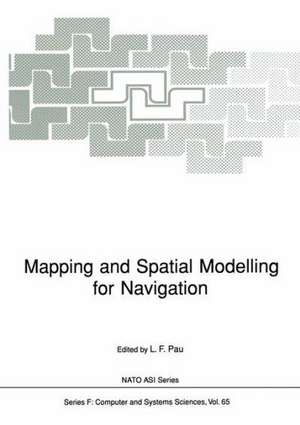Mapping and Spatial Modelling for Navigation: NATO ASI Subseries F:, cartea 65
Editat de Louis F. Pauen Limba Engleză Paperback – 16 ian 2012
Din seria NATO ASI Subseries F:
- 20%
 Preț: 650.27 lei
Preț: 650.27 lei - 20%
 Preț: 668.55 lei
Preț: 668.55 lei - 20%
 Preț: 992.44 lei
Preț: 992.44 lei - 18%
 Preț: 1239.19 lei
Preț: 1239.19 lei - 20%
 Preț: 1922.81 lei
Preț: 1922.81 lei - 20%
 Preț: 654.37 lei
Preț: 654.37 lei - 18%
 Preț: 1234.00 lei
Preț: 1234.00 lei - 20%
 Preț: 709.78 lei
Preț: 709.78 lei - 20%
 Preț: 656.03 lei
Preț: 656.03 lei - 18%
 Preț: 1854.94 lei
Preț: 1854.94 lei - 20%
 Preț: 374.97 lei
Preț: 374.97 lei - 20%
 Preț: 991.94 lei
Preț: 991.94 lei - 20%
 Preț: 671.02 lei
Preț: 671.02 lei - 20%
 Preț: 1925.96 lei
Preț: 1925.96 lei - 20%
 Preț: 994.73 lei
Preț: 994.73 lei -
 Preț: 389.49 lei
Preț: 389.49 lei - 20%
 Preț: 657.99 lei
Preț: 657.99 lei - 20%
 Preț: 655.20 lei
Preț: 655.20 lei - 18%
 Preț: 1225.31 lei
Preț: 1225.31 lei - 18%
 Preț: 952.09 lei
Preț: 952.09 lei - 20%
 Preț: 332.06 lei
Preț: 332.06 lei - 20%
 Preț: 1284.47 lei
Preț: 1284.47 lei - 20%
 Preț: 644.81 lei
Preț: 644.81 lei -
 Preț: 395.85 lei
Preț: 395.85 lei - 18%
 Preț: 1221.07 lei
Preț: 1221.07 lei - 15%
 Preț: 643.34 lei
Preț: 643.34 lei - 20%
 Preț: 645.47 lei
Preț: 645.47 lei - 20%
 Preț: 1282.98 lei
Preț: 1282.98 lei - 20%
 Preț: 656.36 lei
Preț: 656.36 lei - 20%
 Preț: 1283.31 lei
Preț: 1283.31 lei - 20%
 Preț: 1924.15 lei
Preț: 1924.15 lei - 20%
 Preț: 362.24 lei
Preț: 362.24 lei
Preț: 652.54 lei
Preț vechi: 815.68 lei
-20% Nou
Puncte Express: 979
Preț estimativ în valută:
124.88€ • 129.89$ • 103.09£
124.88€ • 129.89$ • 103.09£
Carte tipărită la comandă
Livrare economică 15-29 aprilie
Preluare comenzi: 021 569.72.76
Specificații
ISBN-13: 9783642842177
ISBN-10: 3642842178
Pagini: 372
Ilustrații: VIII, 357 p.
Dimensiuni: 170 x 242 x 20 mm
Greutate: 0.61 kg
Ediția:Softcover reprint of the original 1st ed. 1990
Editura: Springer Berlin, Heidelberg
Colecția Springer
Seria NATO ASI Subseries F:
Locul publicării:Berlin, Heidelberg, Germany
ISBN-10: 3642842178
Pagini: 372
Ilustrații: VIII, 357 p.
Dimensiuni: 170 x 242 x 20 mm
Greutate: 0.61 kg
Ediția:Softcover reprint of the original 1st ed. 1990
Editura: Springer Berlin, Heidelberg
Colecția Springer
Seria NATO ASI Subseries F:
Locul publicării:Berlin, Heidelberg, Germany
Public țintă
ResearchCuprins
1. Mapping and spatial modelling for navigation: a survey.- Spatial Data Structures.- 2. Spatial data structures: the extension from one to two dimensions.- 3. Hierarchical data structures for spatial reasoning.- 4. A spherical model for navigation and spatial reasoning.- Mapping Systems.- 5. Tools for geometric data acquisition and maintenance.- 6. MARIS: Map recognition input system.- 7. Pattern classification from raster data using vector lenses, neural networks and expert systems.- Cartographic Feature Extraction from Imagery.- 8. Toward automatic cartographic feature extraction.- 9. ICARE: an expert system for automatic mapping from satellite imagery.- 10. Understanding images by reasoning in levels.- 11. Generation and processing of geomorphic models.- Mobile Robot Navigation from Maps.- 12. Local perception and navigation for mobile robots.- 13. Geometric models for navigation.- 14. Distributed control for collision avoidance between autonomous vehicles.- 15. Improved navigation, spatial mapping, and obstacle avoidance capabilities for mobile robots and AGV’s.- 16. Approaches to route planning and guidance in the UK.- Operational and Research Needs.- 17. The cause and effect of the demand for digital geographic products.- 18. Spatial modeling in a national charting agency.- 19. Research interests at the Defence Mapping Agency.


















